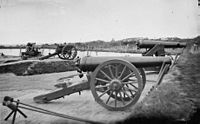
Two Model 1829 32-pounder siege and garrison guns rifled using the James method. The one in the foreground is on a siege carriage. The one behind is on an iron, front pintle, barbette carriage.
James rifle is a generic term to describe any artillery gun rifled to the James pattern for use in the American Civil War. Charles T. James developed a rifled projectile and rifling system. Modern authorities such as Warren Ripley and James Hazlett have suggested that the term "James rifle" only properly applies to 3.80" bore field artillery pieces rifled to fire James' projectiles. They contend that the term does not apply to smoothbores that were later rifled to take the James projectiles in 3.67" caliber or other calibers, and that those should instead be referred to as "Rifled 6 (or other) pounder", etc.[1][2]
Field artillery[]
Early in the war there were many 6-pounder bronze guns in service with the field artillery and few rifled pieces available. A number of these guns were rifled to fire the 3.67" caliber James projectile. These are classified as "rifled 6-pounder guns" or alternately as 12-pounder James rifles.[3]
James worked with Ames Manufacturing Company, Chicopee, Massachusetts to produce 3.80" bore rifled cannon in at least six known variants. Collectively these are referred to as 14-pounder James rifles. The initial type was reaming of existing 6-pounder Model 1841 guns to 3.80", then rifling. This eliminated any deviations from tube wear—a common problem with bronze cannon that had already seen service. The other five types were new pieces all using the smooth curves of the Ordnance profile. The first five variants were bronze, while the final type was iron.[4]
The James projectiles were falling out of favor by the time of the inventor's death in late 1862, and the various James rifles were gradually phased out of service in favor of other types. Those still in service often used Hotchkiss ammunition.[5] A key factor in demise of these pieces was how quickly "bronze rifles became inaccurate through wear or stretching or both."[6]
[]

A James pattern solid shot. The “birdcage” at the base would have been covered by sheet lead which, upon firing the gun, would have expanded into the grooves of the rifling.
During the early part of the war, the Federal army lacked rifled siege artillery. To fill this gap, the army rifled existing smoothbore pieces with the system developed by Charles T. James. Firing shot and shells also designed by James, these newly-rifled smoothbores gave good service during the April 1862 bombardment of Fort Pulaski. However they were retired from frontline service soon after.
Smoothbore guns Rifled with James System
| Name | Bore | Weight
of projectile |
Weight
of gun |
Length
of gun |
|---|---|---|---|---|
| 24-pdr M. 1839, rifled
(48-pdr James rifle) |
5.82 in. | 48 lb.
(shot) |
5,790 lb. | 124 in. |
| 32-pdr M. 1829, rifled
(64-pdr James rifle) |
6.4 in. | 64 lb.
(shot) |
7,531 lb. | 125 in. |
| 42-pdr M. 1841 rifle
(84-pdr James rifle) |
7 in. | 64 lb.
(shell) |
8,465 lb. | 129 in. |
Notes[]
References[]
- Dickey, Thomas S. and George, Peter C., Field Artillery Projectiles of the American Civil War, Atlanta, GA: Arsenal Press, 1980.
- Hazlett, James C., Edwin Olmstead, and M. Hume Parks. Field Artillery Weapons of the American Civil War, rev. ed., Urbana: University of Illinois Press, 1983. ISBN 0-252-07210-3.
- Ripley, Warren. Artillery and Ammunition of the Civil War. 4th ed. Charleston, SC: The Battery Press, 1984. OCLC 12668104.
The original article can be found at James rifle and the edit history here.